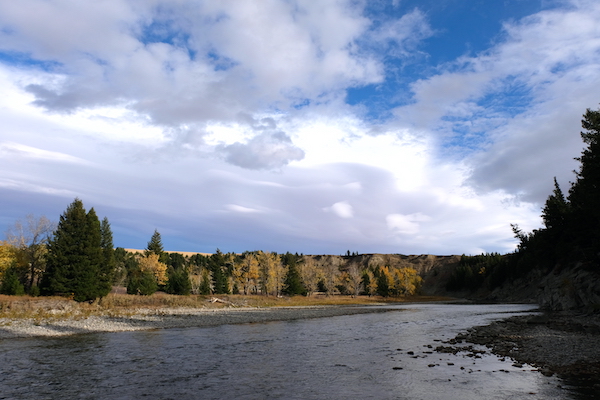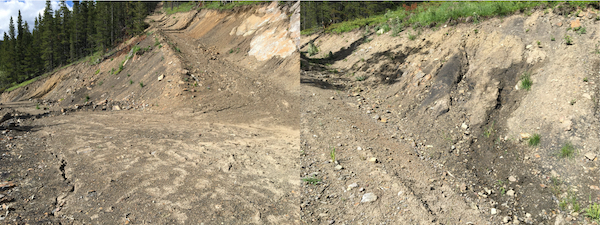Loving One’s Water Mother

“The windy forests of the high foothills and Front Ranges are the birthplace of rivers: rivers like the Oldman, beside whom I sit most evenings on what I’ve come to know as the whiskey chair. Sometimes, I hold a glass of ice cubes flavored with a bit of whiskey, other times, a cup of warm tea or hot chocolate, but regardless of what is cradled on my lap the river is the same—chattering steadily as it courses its way between the Douglas firs that shelter me and that jungle of young poplars on the gravel island that appeared a few years ago after a larger than usual spring flood. It’s a young river here so near to its birth places; still eager and full of purpose.”—Kevin Van Tighem
While I Draw Breath
By Kevin Van Tighem

CANMORE, ALBERTA Canada—(Weekly Hubris)—1 December 2022—The windy forests of the high foothills and Front Ranges are the birthplace of rivers: rivers like the Oldman, beside whom I sit most evenings on what I’ve come to know as the whiskey chair. Sometimes, I hold a glass of ice cubes flavored with a bit of whiskey, other times, a cup of warm tea or hot chocolate, but regardless of what is cradled on my lap the river is the same—chattering steadily as it courses its way between the Douglas firs that shelter me and that jungle of young poplars on the gravel island that appeared a few years ago after a larger than usual spring flood. It’s a young river here so near to its birth places; still eager and full of purpose.
Some of the floods have been larger than usual, of late. Since we took on the responsibility of caring for our piece of God’s country back in 1993, we’ve seen four “hundred-year floods.” The big ones can be horrifying in the moment—hungry, roaring surges of chocolate water loaded with flotsam, pounding against the outsides of each bend, collapsing cliffs, pulsing through the cottonwood groves, and pouring across our buckbrush flats. But when they pass, and they always do, they often turn out to have given birth to millions of new willows and poplars whose seeds drifted on the June winds to light on fresh deposits of silt and gravel along the river edge. Spring floods are birth events, at least for river forests.
If Earth is our mother, she is constantly giving birth: to poplar forests along the downstream river and to the river itself along the eastern slopes of the Rocky Mountains. Each spring she gives birth to billions of plants that lift green arms to the sky and push new roots deep into the living earth, making it soft. Amid all that greenery, does give birth to fawns and eggs hatch in nests. Mother bears emerge blinking from their dens, followed by newborn cubs who have never heard a river before. The river tells them of its birth, and a thousand other things a bear needs to know, as the mother planet goes spinning through the sky at this far edge of a universe that has offered, so far, no hint of life anywhere else in all its cosmic vastness. Birth might be a phenomenon that exists only here on this living planet—making it that much more miraculous.
This spring, I went up into the birthplace of our home river because it’s always been a good place to be. But there were problems there; birth complications. Hiking up a newly-bulldozed road on Cabin Ridge, I saw steep sidehill cuts oozing water, the soil dark and shiny like a head wound that won’t stop bleeding. The water draining down the open faces of savaged soil collected in ditches full of silt and algae. In some places, so much groundwater was escaping from the hillside that it formed rills and brooks that chattered cheerily along beside the sun-blasted road. It was a happy sound—or it would have been, had I not known what those cheery little rivulets were doomed soon to discover: that they would evaporate into nothing before they reached the valley floor.

Rivers are born of meltwaters and runoff that originate on the land. Shaded by vegetation, soaking into soft spongy soils, much of that spring runoff becomes groundwater. The healthiest rivers are those sustained by groundwater springs. Healthy land; healthy river. But the Oldman no longer enjoys that kind of uncomplicated birth because a century of resource exploitation has left the land wounded. Most recently, coal companies in pursuit of profit felt no compunction about ripping many kilometers of rough road into the mountainsides. The raw cuts release groundwater that would otherwise have filtered slowly down to the river below. The escaping water is trapped in eroding ditches and fans out across the raw scars the bulldozers left behind, where it evaporates in the sun and wind and is gone. It never even reaches the river.
The Oldman is a major tributary of the South Saskatchewan River. Monitoring has shown that the natural flow of the South Saskatchewan has decreased more than 12 percent in the last 60 years. A lot of that decrease is because of lost groundwater—lost to large logging clearcuts that dry out in the summer wind instead of shading moist soils beneath the tree canopy, lost to seepage from coal, oil and logging roads that slice into the slopes and sever shallow aquifers that used to connect with the river below, and lost to compacted roads and off-highway vehicle trails that divert snowmelt and rainwater—and eroded soil—straight into the river each spring instead of letting it soak in.
That quick release of spring runoff is also why we see big spring floods more frequently. And then the summer rivers run shallow and warm for want of what was meant to be their sustaining groundwater flow.
In September, one can forget all this. This is less a season of birth than one of quiet nostalgia, as this year’s generation of newly born birds fly south, fawns lose their spots and begin to look like their mothers, bear cubs grow fat along the river, and leaves begin to fall. The river is always small and quiet at this time of year, as its natural groundwater flows diminish. The bull trout are gone upstream to spawn; for them, at least, it is still a birthing time. For the rest, it’s a time of maturing and moving on.
I like the birth metaphor for the eastern slopes of the Rockies; all our rivers, after all, rise there. But in the face of the harm we continue to wreak upon those hills, ridges, and valleys, another metaphor seems more appropriate. When birthing goes wrong, what was meant to be a time of joy and renewal becomes a time of grief and tears. Those sidehill cuts on the new roads carved so violently into the face of mother Earth glisten with water that will never reach the river. It looks not like birth or renewal; to me it looks like tears. And tears dry up on one’s face. After enough have fallen, all that remains is thirst and sorrow.
This evening, admittedly, the river showed no evidence of grief. Its faith seems boundless. Mine: not so much. We could heal those cuts, dry those tears, restore the wounded slopes and make of those river birthplaces the safe and blessed refuges a mother needs when engaged in the solemn, joyful work of renewing life and re-creating beauty. But we don’t; as if there were no need of birth and renewal anymore.
Of all the processes that give our planet life, it seems to me that birth is among the most sacred. And of all the things that make life possible, water is the most essential. For both those reasons, the birthplaces of our rivers deserve more love, more care, fewer tears, and less violence. If we are ever judged, it seems to me that the first question might well be: “How did you treat your mother?”

One Comment
Daniel Dodson
Four “hundred year floods” – in 30 years: Where Old Man River is too young to be bound by our math. Real concern that humans may not be the newborn cub when “Mother Earth’s maternal instincts bear down…. DD-30º-DD